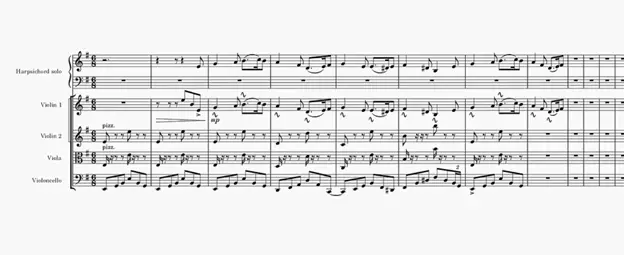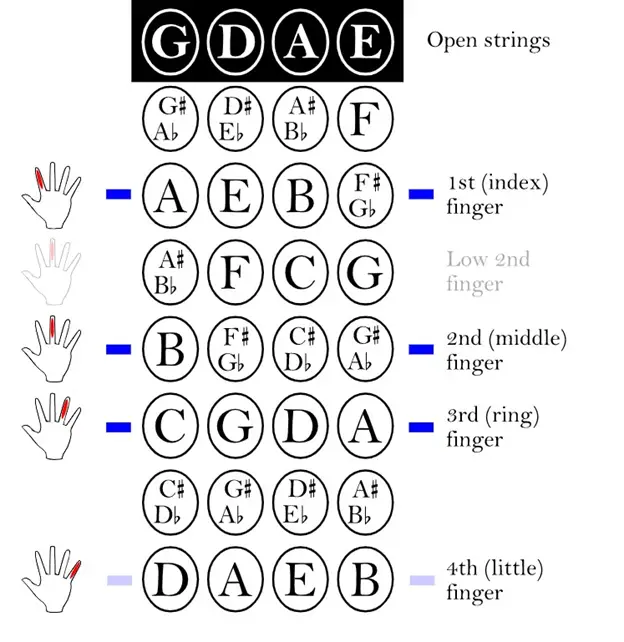Violin Notes for Beginners: All Basics Explained
You must first learn how to play individual violin notes on the violin before moving on to learning how to play pieces. If you’re thinking about what notes are on each violin string, how to use your finger and where to place it to play those notes, and how to easily recognize them, we’ve got you covered.
When you begin learning to play the violin or any other instrument, reading music becomes critical. After all, being capable of reading the music you’re playing not only allows you to play it but also allows you to grasp it better!
Contents
What is a Violin String?
The violin’s four strings are tuned in 5ths. The string names are G (G3), D (D4), A (A4), and E (from right to left) (E5).
The E string is the thinnest and has the highest pitch, while the G string is the thickest and has the lowest pitch.
What Are the Different Violin Notes?
A violin consists of twelve notes: A, A#, B, C, C#, D, D#, E, F, F#, G, G#. The G3 is the lowest note on the violin, and the A7 is the highest note.
There are eight different notes that you can play in the first position on each string. You can begin by playing the open string. Then there are two notes that you can play with your first finger.
The second finger is used to play the next two notes. The third finger is used for the following two notes. With the fourth finger, you play the last note on each string.
First Violin Position
The first position is referred to as the “basic violin position.” The term position refers to the left hand’s position, whereas first refers to the “first position” on the fingerboard – that is, the position nearest to the scroll.
If you place your left hand higher on the fingerboard, the higher will be the position number. You must consider this fact as it’s important to understand that each string contains more than 8 notes.
However, in our first year of violin playing, we normally just concentrate on teaching the notes in the first position. After you’ve memorized all of the notes in the first position, you can move on to higher positions.
You can also just play in the first position for the rest of your life. You only need to play in the first position in many types of music, such as folk music.
If you’re a beginner, however, stick to basic first-position songs until you’ve mastered the basics!
All the Violin Notes in Sheet Music
The Basics start with understanding the staff, clef, key signature, and time signature.
The path to learning how to read sheet music begins with the staff. In basic violin sheet music, the staff is a set of five horizontal lines on which notes are placed. Each of these lines and spaces represents a different pitch or note. We read music from left to right, and there’s a clef symbol on the left side.
Since this clef differs for bass and treble clef, it will help you identify the names of the notes on that staff.
The key signature is right next to the clef. The key signature is made up of sharps and flats markings that indicate which notes in that piece of music are altered.
In music, multiple pitches correspond to the same letter. On the violin, for example, there are several different A’s. They’re just in different pitches, higher or lower.
To learn violin music notes in an easy way, divide the staff into lines and spaces.
The time signature is a symbol that specifies the number of beats per measure as well as the type of note that receives a beat. Usually, two numbers will be stacked on top of one another.
Memorizing the various symbols found on the staff is an essential part of learning how to read violin notes. You’ll notice some new symbols at the beginning of each staff line if you look through some violin sheet music or an exercise book.
The Violin Fingerings
Understanding violin fingering is a quick and easy way for beginning violinists to practice reading sheet music. Learning to associate which finger to place when making each note is particularly important. This will take some time.
The numbers above the staff on the chart indicate the correct playing finger (fingering) for the corresponding note written on the staff.
A violinist must memorize where their finger should be placed on the fingerboard. Beginner violin students can help with this by putting tape on their violin in the right place to play the correct pitch and learn violin fingerings.
The Note Names
The notes on the G string are denoted by the letters below the staff. They correspond to the writing on the staff directly above them.
The lower half of the chart shows where the notes are on the fingerboard and which finger position is used to play them. This way, you’ll be able to figure out which finger placement belongs to which note.
Conclusion
Learning to read music, and also recognizing the notes on the violin and how to finger the violin, is an important part of your development as a violinist. It will make the learning process of new pieces more entertaining for you.
Violin Note FAQs
Can I learn to play the violin on my own?
You certainly can! There are numerous tutor books and websites available for learning the violin. Many musicians began in this manner, and teachers can step in as needed for one-time or occasional guidance.
How long does it take to play the violin in tune?
The time it takes to play the violin in tune varies greatly from person to person. On average, it takes three to five years for an adult beginner to achieve good intonation on the violin.
What are the different strings on my violin?
G, D, A, and E are the strings on a violin. The highest pitch and thinnest string is E, while the lowest pitch and thickest string is G.
- Viola vs Violin – 5 Key Differences Between The Two Instruments - March 20, 2024
- 15 of the Most Famous Violinists of All Time (18th Century to Present) - March 20, 2024
- Full School Band Instruments List (Elementary / Middle / High) - March 18, 2024



